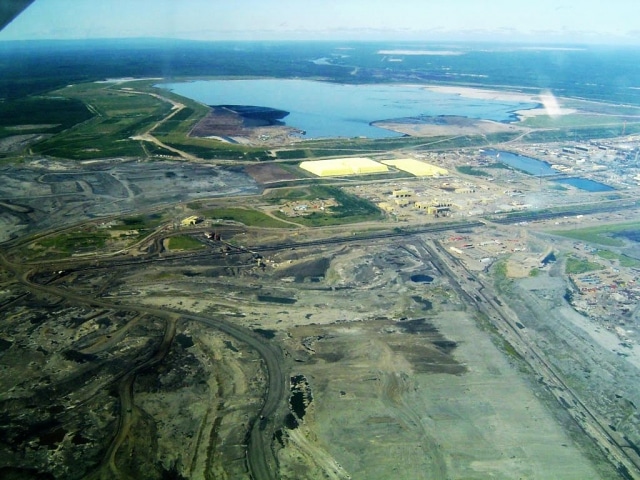On the Friday before Labor Day — in the form of an age-old “Friday News Dump“ — the Federal Energy Regulatory Commission (FERC) handed a permit to Enbridge, the tar sands-carrying corporate pipeline giant, to open a tar sands-by-rail facility in Flanagan, Ill. by early-2016.
With the capacity to accept 140,000 barrels of tar sands product per day, the company’s rail facility serves as another step in the direction towards Enbridge’s quiet creation of a “Keystone XL Clone.” That is, like TransCanada’s Keystone Pipeline System sets out to do, sending Alberta’s tar sands all the way down to the Gulf of Mexico’s refinery row — and perhaps to the global export market.
Flanagan sits as the starting point of Enbridge’s Flanagan South pipeline, which will take tar sands diluted bitumen (“dilbit”) from Flanagan to Cushing, Okla. beginning in October, according to a recent company earnings call. From there, Enbridge’s Seaway Twin pipeline will bring dilbit to Port Arthur, Texas near the Gulf.
Enbridge made the prospect of a tar sands-by-rail terminal public for the first time during its quarter two investor call.
“In terms of the rail facility, one of the things we’re looking at is – and the rail facility is really in relation to the situation in western Canada where there is growing crude oil volumes and not enough pipeline capacity to get it out of Alberta for a two or three year period,” Guy Jarvis, president of liquids pipelines for Enbridge, said on the call.
“So, one of the things we’re looking at doing is constructing a rail unloading facility that would allow western Canadian crudes to go by rail to Flanagan, be offloaded, and then flow down the Flanagan South pipeline further into Seaway and to the Gulf.”
FERC has given Enbridge the permit it needs to make that happen.
Enbridge “Scheme” Receives MN Permit
The announcement comes just days after the U.S. Department of State handed Enbridge a controversial permit to move an additional 350,000 barrels of tar sands per day across the U.S.-Canada border without the legally conventional Presidential Permit, public hearings or an environmental review conducted by the State Department.
Enbridge also received a permit from the Minnesota Public Utilities Commission (MPUC) the day before FERC‘s “Friday News Dump,” locking in the State Department’s legal ruling at the state-level. MPUC voted 4-1 to permit the pipeline after a meeting lasting nearly eight hours.
The Commission did so even though the staffer analyzing comments and legal submissions acknowledged he reviewed far more climate and environmental concerns than vice versa, according to MPUC staff briefing papers reviewed by DeSmogBlog.
“Clearly there exists much public opposition to the increased consumption of fossil fuels and diluted bitumen sources in particular,” wrote Michael Kaluzniak, planning director for energy facilities permitting for MPUC.
“Additionally, the Commission received numerous comments expressing genuine concern regarding the potential impact of the project on water quality and overall dissatisfaction with Enbridge’s public safety and spill response actions.”
TransCanada and Tar Sands by Rail
With the combination of its Alberta Clipper expansion “illegal scheme” (referred to as such by the National Wildlife Federation), Flanagan South and Seaway Twin pipelines, as well as the FERC-approved rail facility, Enbridge now has the capacity to bring roughly 960,000 barrels per day of tar sands product to the Gulf.
For sake of comparison, Keystone XL has the capacity to bring 830,000 barrels per day of tar sands to the Gulf. But TransCanada has also brokered its own deals and made its own chess moves.
As reported on DeSmogBlog, TransCanada may build its own tar sands-by-rail facility while it waits for Keystone XL‘s northern leg to receive — or not receive — a State Department permit and accompanying Presidential Permit.
“It is something…that we can move on relatively quickly,” TransCanada CEO Russ Girling stated on his company’s quarter one earnings call. “We’ve done a pretty substantial amount of work at the terminal end and mostly at the receipt and delivery points and that’s really what our key role in here would be.”
Since that call, TransCanada has not discussed its tar sands by rail business plans.
“Keystone? Who needs it?”
In July, Global Partners and Kansas City Southern announced plans to develop a tar sands by rail facility in Port Arthur, Texas with 340,000 barrels of storage capacity.
If TransCanada opens up its own tar sands by rail facility, the combination of that and Enbridge’s latest tar sands by rail move could feed the Global Partners-Kansas City Southern beast.
With tar sands now “Texas Bound and Flyin” in a major way, and both Enbridge and TransCanada finding a way to get tar sands to the Gulf, the seemingly hyperbolic headline published on July 10 by the Houston Business Journal seems to ring true more now than ever: “Keystone? Who needs it?”
Photo Credit: Wikimedia Commons
Subscribe to our newsletter
Stay up to date with DeSmog news and alerts






